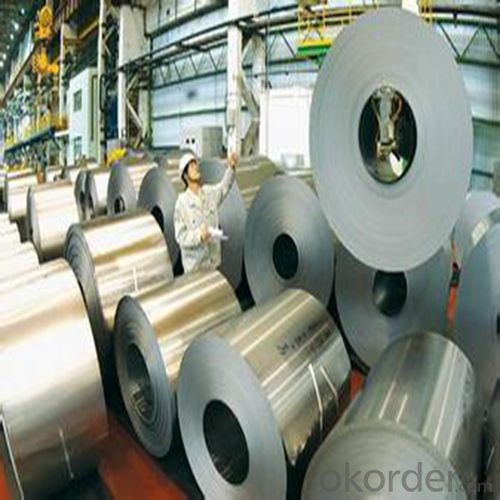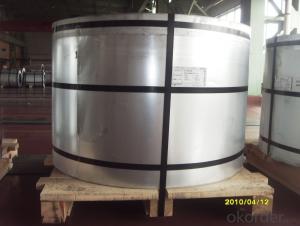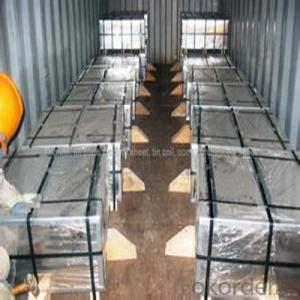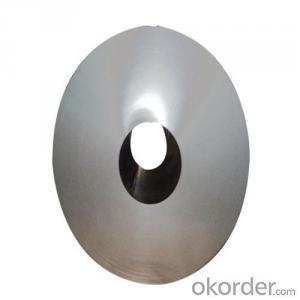Electrolytic Tinplate ETP for Food Containers Use
- Loading Port:
- Qingdao
- Payment Terms:
- TT OR LC
- Min Order Qty:
- 25 m.t.
- Supply Capability:
- 30000 m.t./month
OKorder Service Pledge
OKorder Financial Service
You Might Also Like
1.Structure of Electrolytic Tinplate ETP for Food Containers Use Description
Electrolytic Tinplate is a thin steel sheet coated by tin. It has an extremely beautiful metallic luster as well as excellent properties in corrosion resistance, solder ability, and weld ability.
2.Main Features of the Electrolytic Tinplate ETP for Food Containers Use
Electrolytic Tinplate undoubtedly enjoys the pride of place as a packaging medium especially for food. It owes its unique position to its "nine layer sandwich structure", each of which contributes to its eminence as a packing material. The steel base of electrolytic tinplate provides the necessary strength and formability for can fabrication. The tin-iron alloy layer provides the bond between the steel and free tin layer. The free tin layer is not only responsible for the attractive bright finish and ease of solderability but is also non-toxic- a factor of vital importance in food packaging!
Tinplate is also widely used for making all types of containers such as food cans, beverage cans, and artistic cans, tea cans, painting cans, chemical package cans and dry food package cans, metal printing etc. Its applications are not limited to containers; recently, electrolytic tinplate has also been used for making electrical machinery parts and many other products.
3.Electrolytic Tinplate ETP for Food Containers Use Images


4.Electrolytic Tinplate ETP for Food Containers Use Specification
Standard:JIS G3303
Material: MR
Thickness:0.35mm
Width: 750
Temper: T3
Annealing: BA
Coil Inner Diameter: 508mm
Weight: 7 tons/coil
Passivation:311
Oil: DOS
Surface: Finish,bright,
5.FAQ of Electrolytic Tinplate ETP for Food Containers Use
1. What is the delivery time for your prime quality tinplate?
Usually 35 days after order confirmation.
2. What is your Minimum Order Quantity?
Usually MOQ is 50tons for one single size, for trial order, it can be 25 tons.
3. What is the payment term?
The most common we use is L/C at sight or TT. We can also try use other terms.
- Q:What are the main factors affecting tinplate coil surface quality?
- The main factors affecting tinplate coil surface quality include the cleanliness of the steel substrate, the quality of the tin coating, the level of oil or grease residues, and the presence of any defects or imperfections on the surface. Additionally, factors such as the processing conditions during manufacturing, handling and storage practices, and the environment in which the tinplate is exposed can also impact the surface quality.
- Q:How is tinplate used in the beverage industry?
- Tinplate is commonly used in the beverage industry for packaging purposes, such as cans for carbonated drinks, fruit juices, and other beverages. The tin coating on the steel sheet provides a protective barrier, preventing corrosion and maintaining the quality and taste of the beverage. Additionally, the versatility of tinplate allows for various shapes and sizes of cans, making it a popular choice for beverage manufacturers.
- Q:What are the different closure mechanisms for tinplate cans?
- The different closure mechanisms for tinplate cans include: slip cover lids, press-on lids, pull-tab lids, twist-off lids, and peel-off lids.
- Q:What are the regulations and standards related to tinplate packaging?
- The regulations and standards related to tinplate packaging vary depending on the country and industry. However, some common regulations and standards include specifications on the composition and thickness of tinplate, labeling requirements for product information and safety warnings, guidelines for food contact materials, and regulations for recycling and environmental sustainability. It is important for manufacturers and suppliers to comply with these regulations to ensure the safety and quality of tinplate packaging.
- Q:Can tinplate be used for microwave-safe packaging?
- No, tinplate cannot be used for microwave-safe packaging as it is a metal material that can cause sparks and potential hazards in the microwave.
- Q:Can tinplate be used for military applications?
- Yes, tinplate can be used for military applications. Tinplate, which is coated with a thin layer of tin to prevent corrosion, offers excellent durability and protection against rust. This makes it suitable for various military equipment and supplies such as ammunition cans, food containers, and other storage solutions. Additionally, tinplate is a cost-effective material that can withstand harsh environments and provide long-lasting performance, making it a reliable choice for military applications.
- Q:How does tinplate ensure the freshness of pet food?
- Tinplate ensures the freshness of pet food by providing a protective barrier that helps to preserve the quality and flavor of the food. It prevents air and moisture from seeping in, thereby minimizing the risk of spoilage and maintaining the nutritional value of the pet food for a longer period of time.
- Q:How is tinplate coated with water-based paints?
- Tinplate is coated with water-based paints through a process called coil coating. In this process, the tinplate is cleaned, pre-treated, and then coated with a water-based paint using a roller or spray method. The paint is then dried and cured at high temperatures to ensure adhesion and durability. The water-based paints are preferred due to their environmental friendliness and ease of application.
- Q:Can tinplate be used for shipping containers?
- Yes, tinplate can be used for shipping containers. Tinplate is a durable material that provides excellent protection against corrosion, making it suitable for shipping containers that need to withstand harsh environmental conditions during transportation.
- Q:What are the main differences between tinplate and tinplate laminates in terms of shelf life?
- The main difference between tinplate and tinplate laminates in terms of shelf life is that tinplate laminates offer better protection against external factors such as moisture and oxygen. The lamination process involves bonding a layer of plastic or other materials to the tinplate, providing an additional barrier against corrosion and contamination. This enhanced protection helps to extend the shelf life of products packaged in tinplate laminates compared to those in regular tinplate.
1. Manufacturer Overview |
|
|---|---|
| Location | |
| Year Established | |
| Annual Output Value | |
| Main Markets | |
| Company Certifications | |
2. Manufacturer Certificates |
|
|---|---|
| a) Certification Name | |
| Range | |
| Reference | |
| Validity Period | |
3. Manufacturer Capability |
|
|---|---|
| a)Trade Capacity | |
| Nearest Port | |
| Export Percentage | |
| No.of Employees in Trade Department | |
| Language Spoken: | |
| b)Factory Information | |
| Factory Size: | |
| No. of Production Lines | |
| Contract Manufacturing | |
| Product Price Range | |
Send your message to us
Electrolytic Tinplate ETP for Food Containers Use
- Loading Port:
- Qingdao
- Payment Terms:
- TT OR LC
- Min Order Qty:
- 25 m.t.
- Supply Capability:
- 30000 m.t./month
OKorder Service Pledge
OKorder Financial Service
Similar products
New products
Hot products
Hot Searches
Related keywords




























